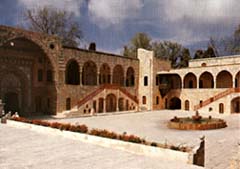Dar El Wousta: The Inner Courtyard
 The
courtyard of Dar El Wousta: this is the middle section of the Palace.
From this point on, the impressive but austere appearance of the outside
court and buildings gives way to the delightful architecture and greenery
that has given Beiteddine its nickname of Lebanon's Alhambra (or so says
Lebanon's Tourism Board). The double staircase in the picture leads to
the private quarters of the Hamade Sheiks, rules of the Chouf mountains,
who built the inner sections of the palace
The
courtyard of Dar El Wousta: this is the middle section of the Palace.
From this point on, the impressive but austere appearance of the outside
court and buildings gives way to the delightful architecture and greenery
that has given Beiteddine its nickname of Lebanon's Alhambra (or so says
Lebanon's Tourism Board). The double staircase in the picture leads to
the private quarters of the Hamade Sheiks, rules of the Chouf mountains,
who built the inner sections of the palace
 Dar
El Kataba facade: To the right as you enter the courtyard one sees
the Dar El Kataba facade, a series of rooms that have held the offices
of local government. The other side of the palace leads to the Dar El Harim,
or the private apartments. There are two levels. The top level consists
of private rooms and the Hamman, or private baths. Following a tradition
dating to Roman times, these baths comprise a cold
Dar
El Kataba facade: To the right as you enter the courtyard one sees
the Dar El Kataba facade, a series of rooms that have held the offices
of local government. The other side of the palace leads to the Dar El Harim,
or the private apartments. There are two levels. The top level consists
of private rooms and the Hamman, or private baths. Following a tradition
dating to Roman times, these baths comprise a cold  room
or frigidarium, used for undressing and for relaxation before and after
the bath. (It is pictured to the right) In this reception room one could
discuss politics or literature or listen to the latest rumors. The second
section of the baths comprise the lukewarm room, or the tepidarium. This
was used for massages and served as a transition between the cold and warm
sections. The third part comprised the warm rooms or caldarium. The paving
stones of the baths were supported by brick pillars and vault with heated
air passing underneath.
room
or frigidarium, used for undressing and for relaxation before and after
the bath. (It is pictured to the right) In this reception room one could
discuss politics or literature or listen to the latest rumors. The second
section of the baths comprise the lukewarm room, or the tepidarium. This
was used for massages and served as a transition between the cold and warm
sections. The third part comprised the warm rooms or caldarium. The paving
stones of the baths were supported by brick pillars and vault with heated
air passing underneath.
 The
Stable and Mosaic Exhibition: The lower level of the inner courtyard
houses the former stables, now a showcase for an extensive collection of
Byzantine mosaics. The largest of them come from the ruins of a Byzantine
church in the coastal city of Jiyyeh, south of Beirut. the Greek inscriptions
appearing on the mosaics date them to the 5th and 6th centuries A.D. Mosaics
from other sites are displayed in these stables and the adjacent gardens.
The
Stable and Mosaic Exhibition: The lower level of the inner courtyard
houses the former stables, now a showcase for an extensive collection of
Byzantine mosaics. The largest of them come from the ruins of a Byzantine
church in the coastal city of Jiyyeh, south of Beirut. the Greek inscriptions
appearing on the mosaics date them to the 5th and 6th centuries A.D. Mosaics
from other sites are displayed in these stables and the adjacent gardens.
Back to Beiteddine
Palace
 The
courtyard of Dar El Wousta: this is the middle section of the Palace.
From this point on, the impressive but austere appearance of the outside
court and buildings gives way to the delightful architecture and greenery
that has given Beiteddine its nickname of Lebanon's Alhambra (or so says
Lebanon's Tourism Board). The double staircase in the picture leads to
the private quarters of the Hamade Sheiks, rules of the Chouf mountains,
who built the inner sections of the palace
The
courtyard of Dar El Wousta: this is the middle section of the Palace.
From this point on, the impressive but austere appearance of the outside
court and buildings gives way to the delightful architecture and greenery
that has given Beiteddine its nickname of Lebanon's Alhambra (or so says
Lebanon's Tourism Board). The double staircase in the picture leads to
the private quarters of the Hamade Sheiks, rules of the Chouf mountains,
who built the inner sections of the palace


